Climbing
I’m aiming to climb competitively in 2025. The questions that I will be trying to answer throughout this process are;
- “what is climbing?”,
- “what does climbing mean to me?”
- “what is my body, or what am I, capable of?”
January 12, 2025 marks the start of my training program.
Routine
Session 1
- Flash Practice (1 hour): Preview and execute circuit problems, one attempt only
- Spray Wall (1-2 hours): Limit projects and power training
- Strength Block: One rep max weighted pull-up, weighted pull-ups 3x6, one arm lock offs timed, fingerboard max hangs timed, core (planks/L-sits/hollow holds/russian twists)
Session 2
- Movement Block (30 minutes): Silent feet traversing, precision footwork drills, hip mobility sequences, body tension exercises
- Technical Climbing (2 hours): Execute competitive climbs, focus on weaknesses
- Strength Block: One rep max weighted pull-up, weighted pull-ups 3x6, one arm lock offs timed, fingerboard max hangs timed, core (planks/L-sits/hollow holds/russian twists)
Session 3
- Flash Practice (1 hour): Preview and execute mixed circuit problems, track accuracy
- Spray Wall (1-2 hours): Continue projects from Monday
- Strength Block: One rep max weighted pull-up, weighted pull-ups 3x6, one arm lock offs timed, fingerboard max hangs timed, core (planks/L-sits/hollow holds/russian twists)
Session 4
- Mock Competition (50 minutes): 2 sets of 4 problems 5 minutes each, 10 minute rest in between sets
- Strength Block: One rep max weighted pull-up, weighted pull-ups 3x6, one arm lock offs timed, fingerboard max hangs timed, core (planks/L-sits/hollow holds/russian twists)
Log
June 7, 2025
There’s levels to everything, and today I was reminded that I ain’t shit.
Today was the Tour de Bloc competition at Joe’s. To say I performed poorly would be an understatement. I don’t even think I really even came close to “performing”.
But what I took from this experience was inspiration. There were some really serious people in the gym today. Some people that saw the competition as an opportunity to benchmark themselves, to display the efforts of their training, to see where they stood. This energy makes me really emotional. It made me think about if I was working towards anything in the same manner.
A timely wake-up call.
I came nowhere close to qualifying for finals but stuck around to watch them. Seeing the finalists give the routes their best tries, failing time and time again in front of a crowd and a loud environment.
I couldn’t help but viscerally feel that I wanted to be up there soon.
March 31, 2025
Today, I sent my first black tape. Although it was a soft-graded black tape. Probably more like a V7, V8 at most.
Still felt pretty rewarding to work on this and send it, think it took me about 40 attempts across 3 sessions.
Getting back into a rhythm, think I’ll be able to consistently climb again 3 times a week while still being able to balance being at the Stadium and managing other projects.
I’m pretty excited.
I don’t think my benchmarks for this month will mean anything, so will get back to training and have something to show for April 11th.
March 15, 2025
Today I was able to climb for the first time in a while since the Stadium opened. I’ve been derailed from my routine, but I know that I ought to get back into it. Climbing balances me.
I had a pretty awful session as you can imagine - nowhere near as strong as I was when I was consistently training. I dropped climbs I knew I could flash, I wasn’t feeling the flow, I was fighting myself more than I was actually climbing the walls.
But it was a good start, and I’m glad I went.
February 14, 2025
Today Wilbur joined me at the gym and we had a lot of fun. I’ve been going against my training program a little bit and have been going into the gym more than I should be, sometimes twice a day (like today). Arian told me that I should probably rest this weekend if I want to train hard next week.
I know this sounds really obvious and I’ve said it time and time again, but sessions like these, and people like Wilbur and Arian, really remind me why I love climbing.
There’s this beautiful thing about the camaraderie, kindness, and laughter that comes from bouldering culture. It’s so fulfilling. My heart feels so full when I’m in the climbing gym. I often lie down and stare at the ceiling to take it all in.
I need to write about this more.
I’ve been really enjoying using this old-school camcorder Daniel gifted me recently (thank you Daniel). I really love filming these slice-of-life, homestyle videos. The way that the climbing gym, its lighting, and the holds show up on this medium is so beautiful to me.
February 13, 2025
I discovered Ashima Shiraishi today and I’m absolutely stunned. I don’t even know how to begin describing how I feel.
After going down the rabbit hole, I stumbled upon Ashima’s talk at the Convergence of Physics and Climbing at Brown University of Physics in 2022 and it was so heartwarming and exciting to hear her own interpretation of climbing and what it means for her.
There’s this moment where she brings up the JJ Gibson’s concept of affordances and very neatly explains the exact reasons why I also love climbing. This idea that, every move on the wall is an intensely pressurized and direct environment in which you can creatively hypothesize what your body - and ultimately - what you are capable of. The entire sport is captured by this - asking if your body can hold this hold, jump this jump, make this move - what is the world affording you to do?
How can humans be so inspiring and cool? It’s so insane to process what we are capable of.
I’m in awe.
February 12, 2025
I just binge watched Erin McNeice’s videos and wow - I can’t express how inspired I feel.
Absolutely insane to me the training regime that these professional athletes go through, and even more insane to process how they’ve dedicated so much of their early life to the sport. It’s so inspiring.
Stories like Erin’s scratch a special spot in my brain. How cool is it that humans can do stuff like this?
I broke down this video in which she went through a regular training (power) day with Louis from Catalyst Climbing and extracted this routine:
- Warm up
- Cardio
- Stretching
- Balance
- 5 minute circuit (5 minutes traversing on wall)
- Fingerboarding
- One arm hangs
- Campusing
- Max effort bouldering (projects)
- Power endurance
- 6x6: 6 laps of the same climb, 6 minutes per lap - resting time is whatever you have left whenever you finish your lap
- Plyometrics
I’m going to give this a shot sometime and see how badly I perform.
February 11, 2025
Spray walled today, sent some V4s, and fucked my shoes. Did a benchmark test, I know I have a lot to improve on but progress is progress.
- 20mm hang: +20lb for 18 seconds
- +20lb from previous benchmark
- Lock offs: 20seconds each hand
- +4 seconds from previous benchmark
- Weighted pull-up: +65lb one rep max
- +10lb from previous benchmark
- L-sit: 27 seconds
- +9 seconds from previous benchmark
- One Arm Scapula Pull-up: 5 each arm
- +5 from previous benchmark
Learning a lot from pushing myself in climbing.
I was watching this climbing video the other day and this line has stuck with me ever since - “you can’t hear good technique”. It hit me that in climbing (and probably quite a few other domains), that when something is executed well, it’s usually invisible to the untrained eye. Good execution is as if the thing doesn’t exist. I wonder how universally applicable this insight is.
The moonboard and spray walls have been really fun to train on. They’re always a bit intimidating, especially when you are constantly being humbled. Despite this, I’m starting to feel like I’m getting the hang of being in this zone of “the moves are hard, but I’m going to try anyways and see what happens”.
I am noticing that by being in this zone more frequently, my physiological response for when I am in tough positions on the wall has also shifted. I am now experiencing less of the feeling that says “wow, this next move is impossible”, and I am now experiencing more of this feeling that says “wait, this is do-able”. It’s funny how that works.
February 8, 2025
Had to re-evaluate my entire training program as some other things in life came up and I can’t visit Up The Bloc on the days that I wanted to anymore.
Today was a really good benchmark session - I wasn’t really feeling great coming in this morning and wasn’t expecting much but spending the session climbing slow and intentionally + spray walling + benchmarking restored a lot of confidence and gave me energy.
Some new benchmarks I hit:
- Weighted Pull-up: +60lb one rep max, 3x6 35lb
- Weighted Dead-hang: 45 seconds with 35lb
January 31, 2025
I competed in my very first (casual) climbing competition today and here’s what I learned.
There were 15 competitive climbs (right to left, 1-15).
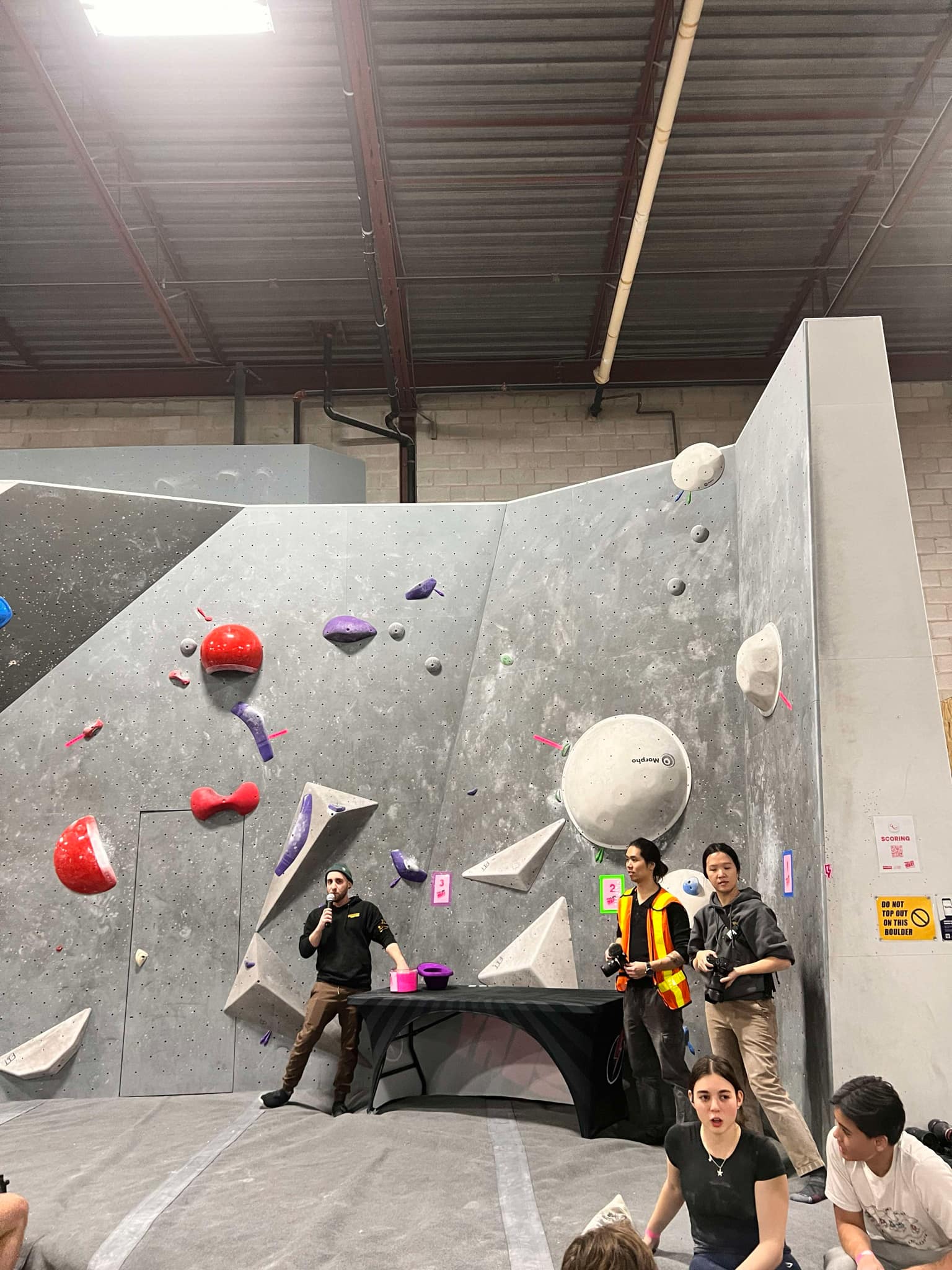
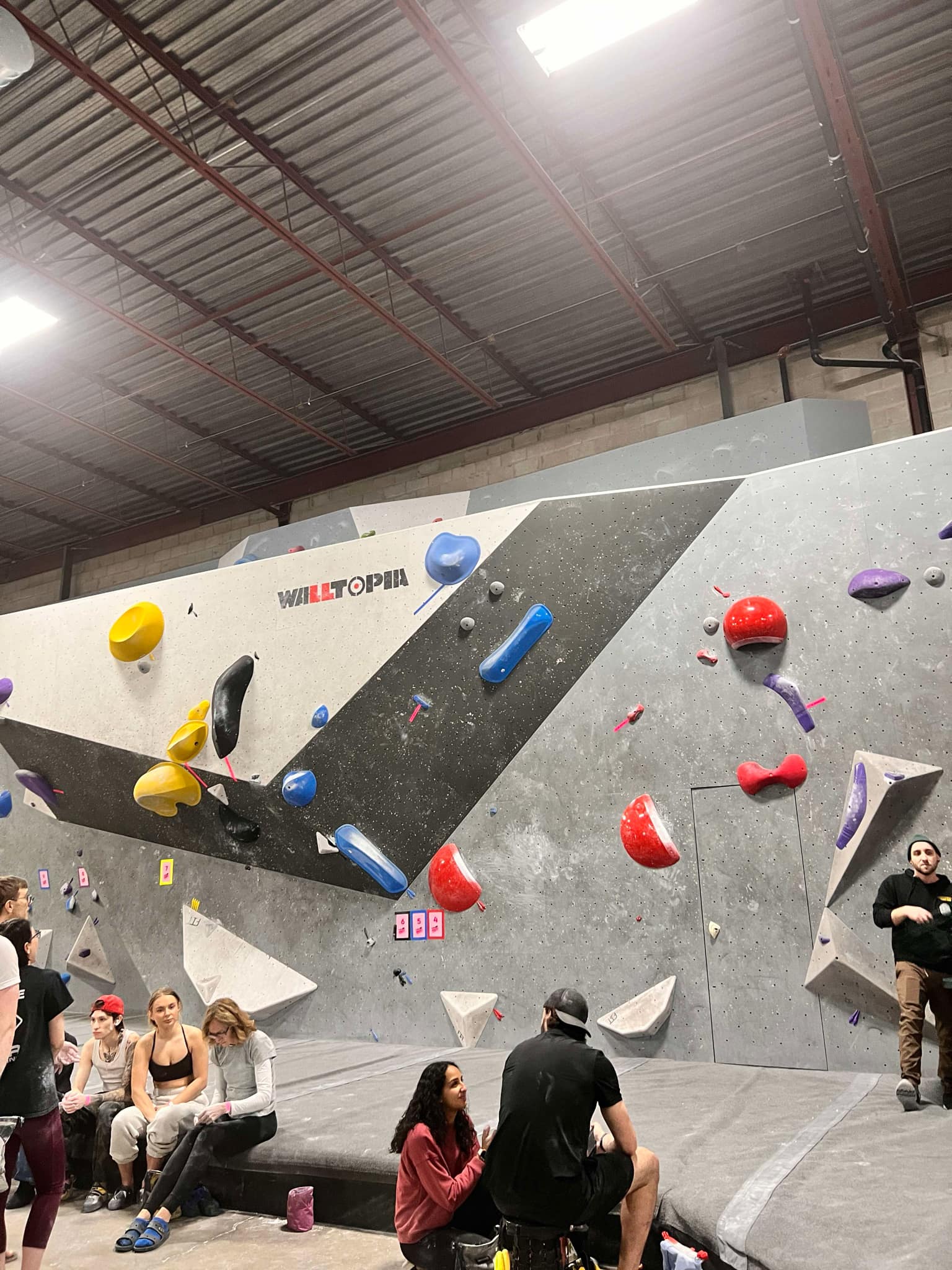
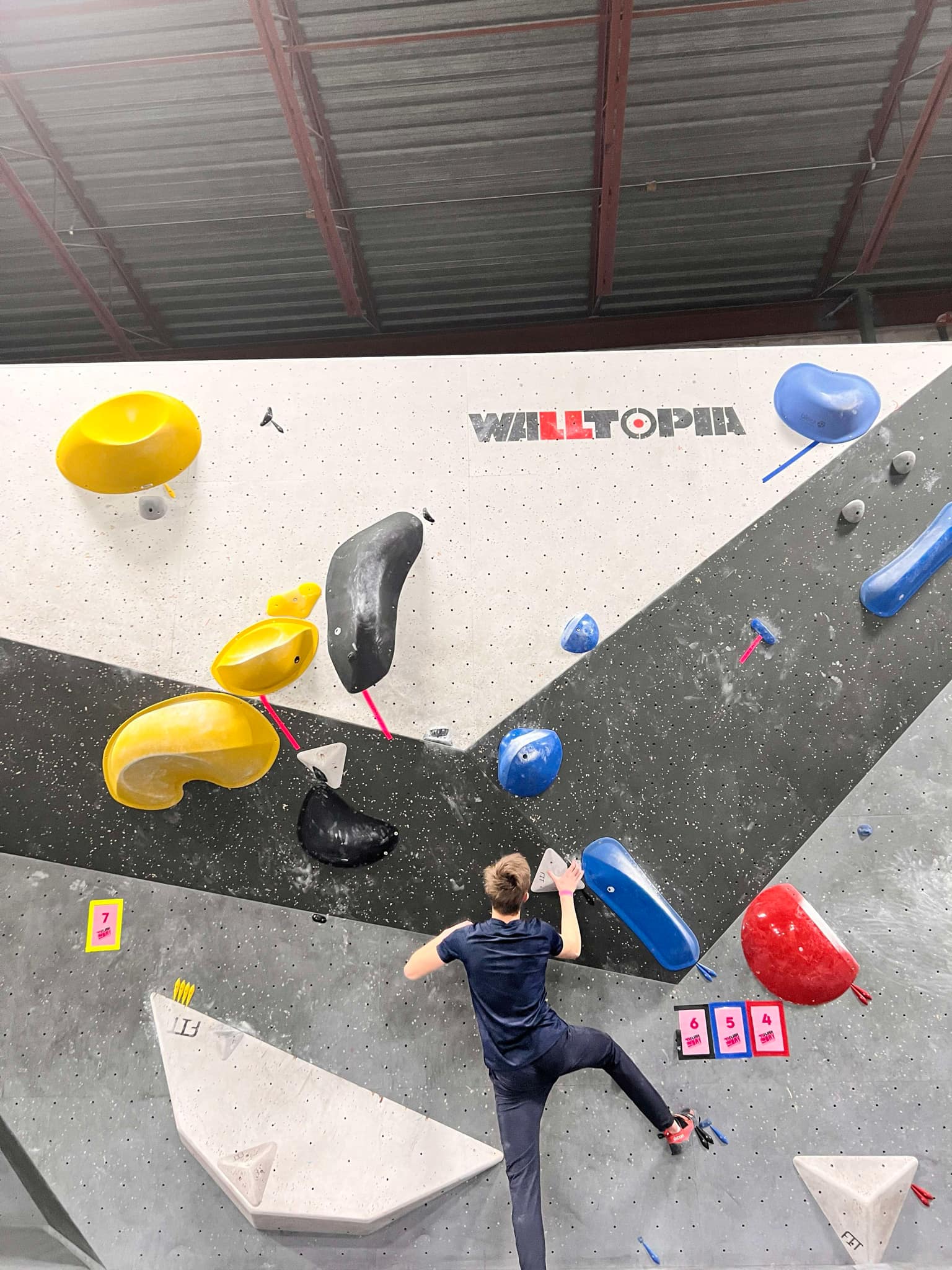
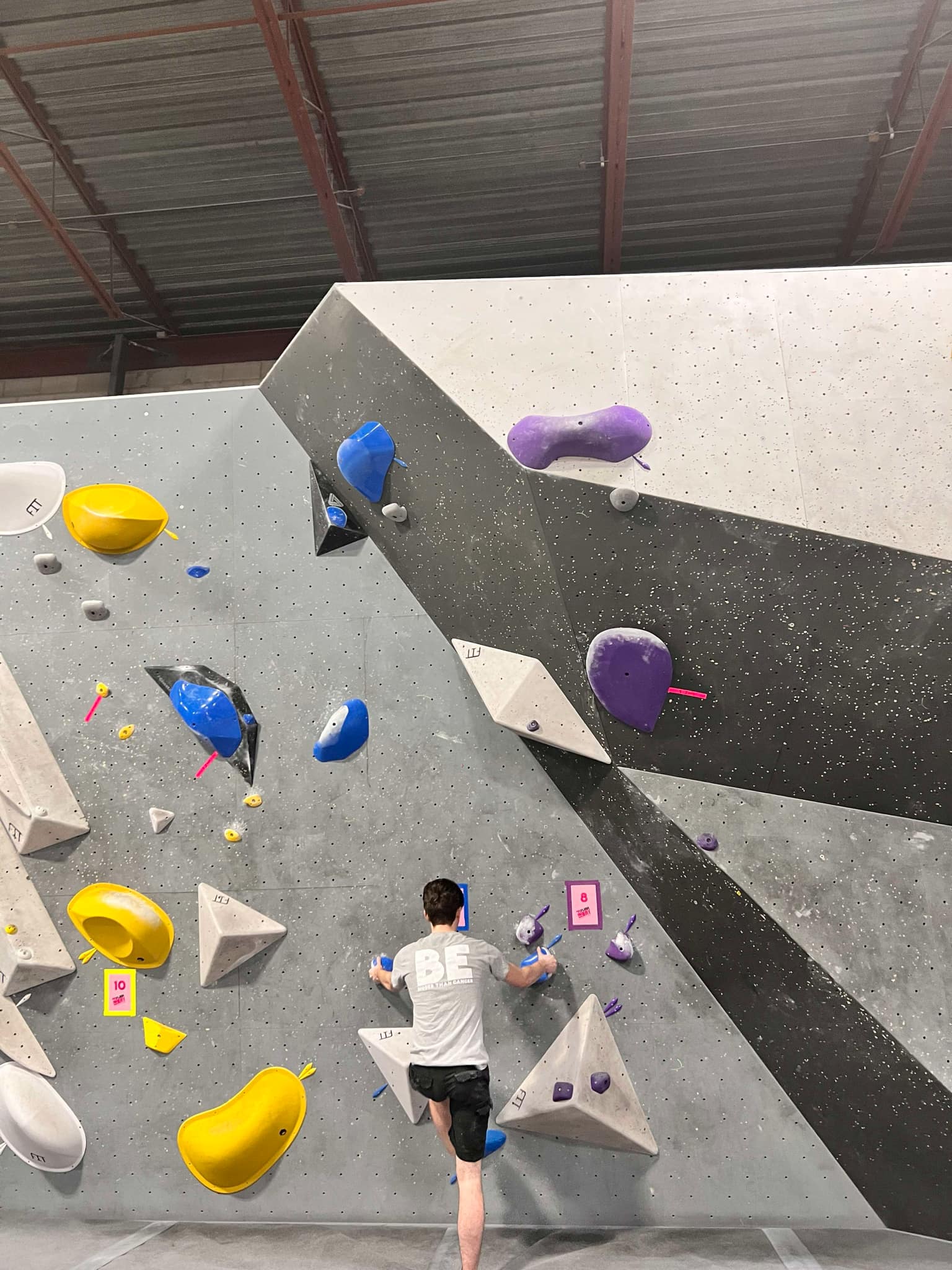
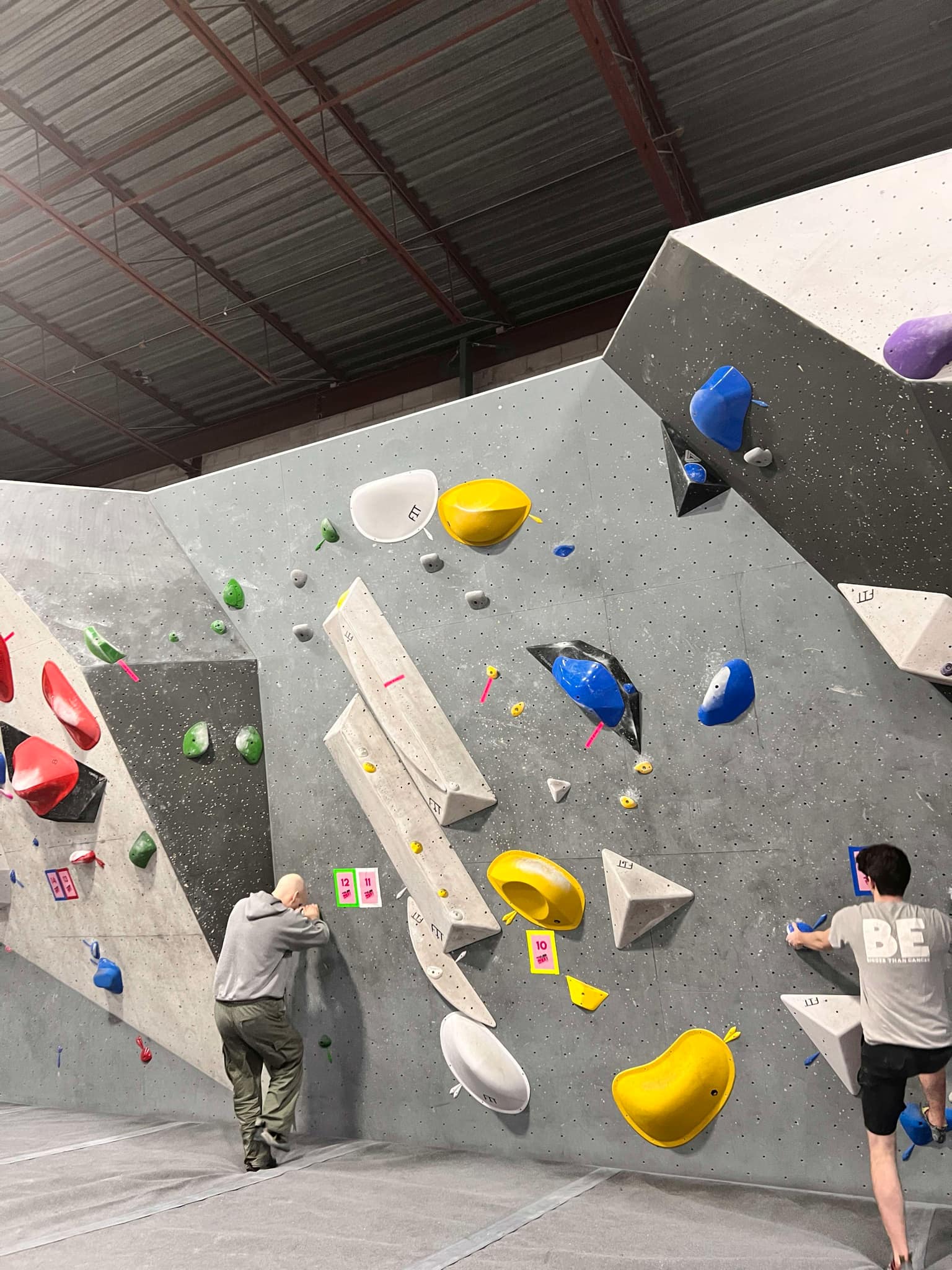
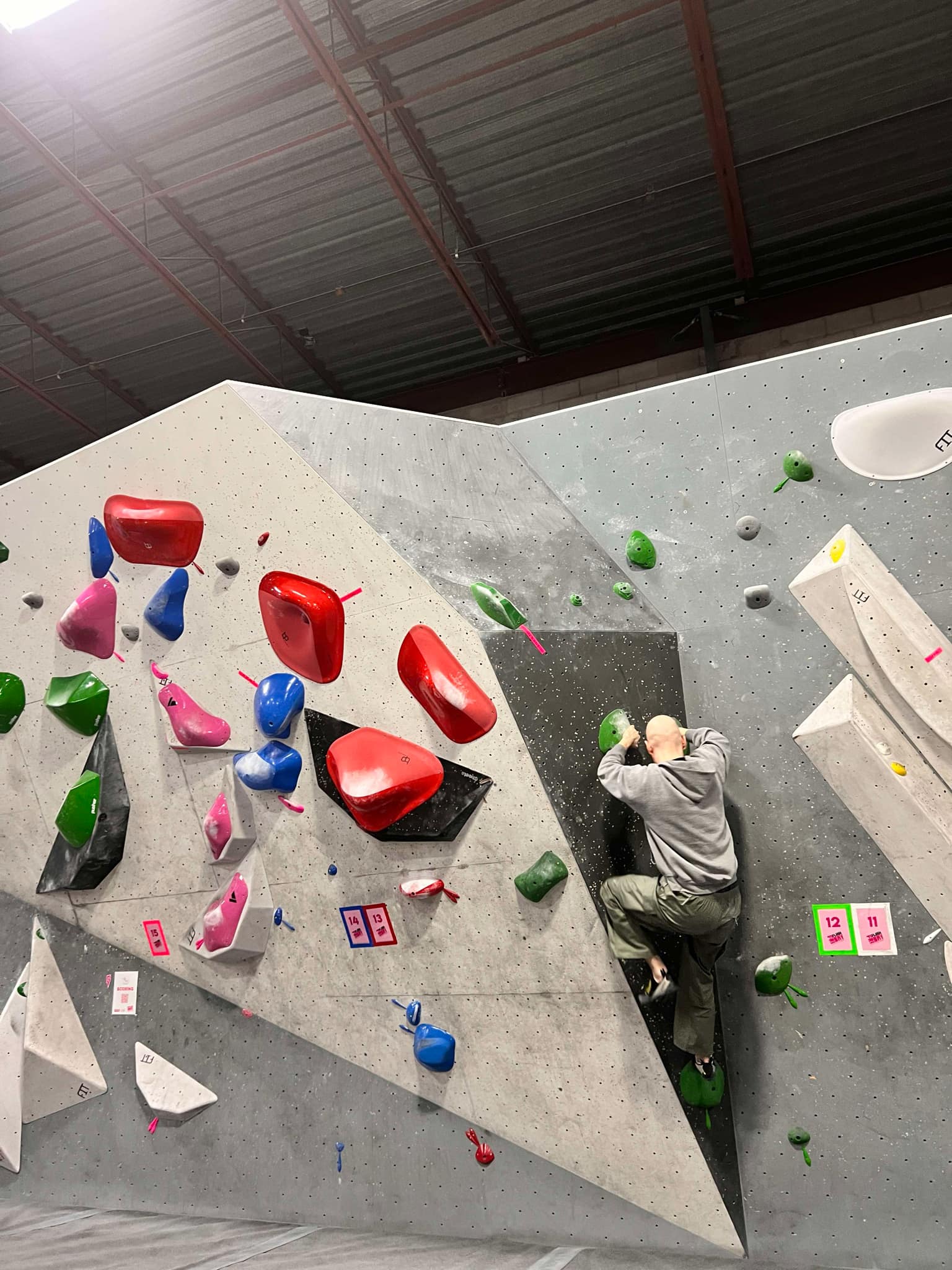
My final scorecard (that I mis-tallied, I actually sent 9 climbs).
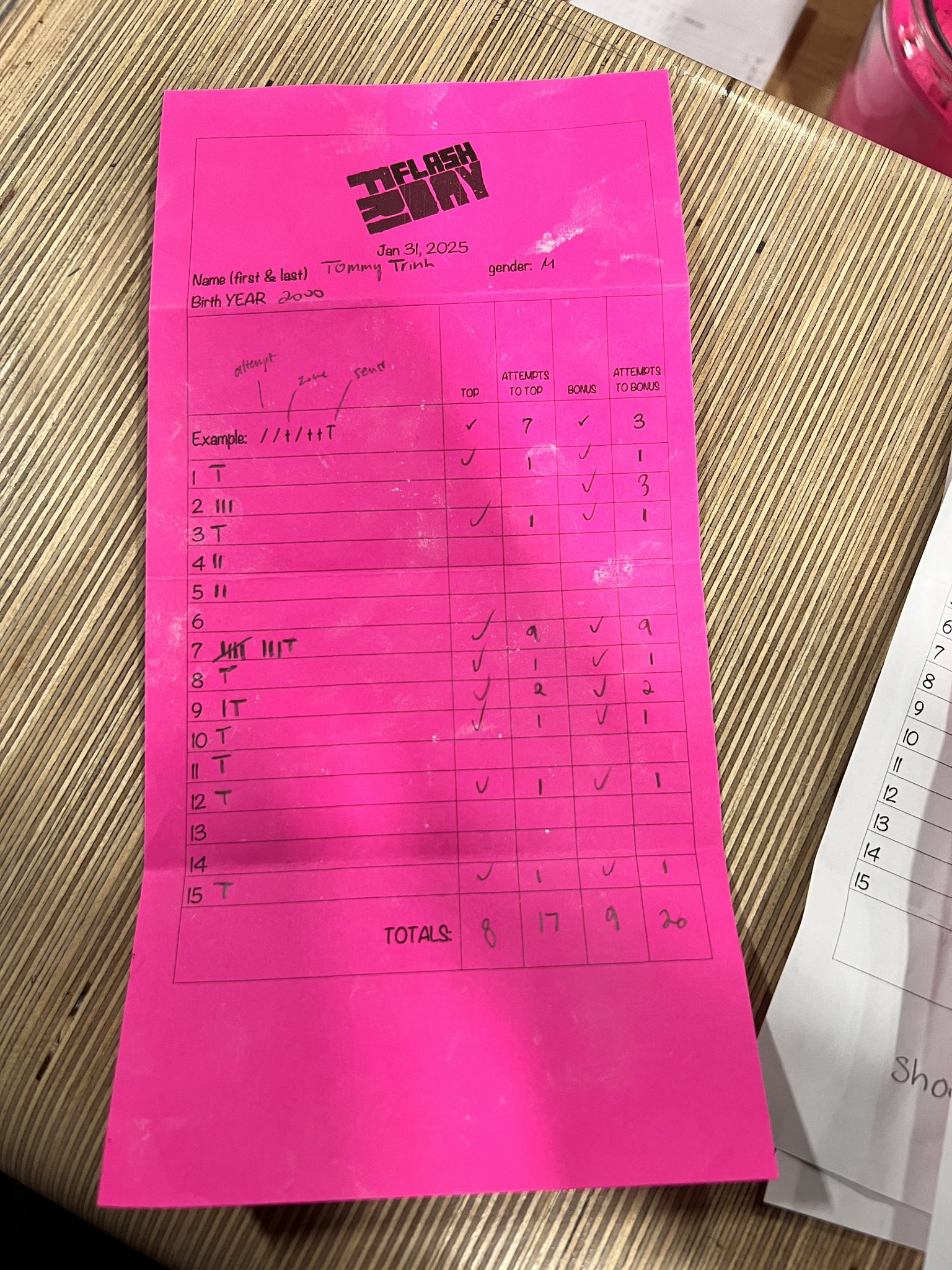
Stats
- I was able to flash 7/15 climbs
- I didn’t try 3/15 climbs at all because they were extremely above my pay grade
- I couldn’t send 3/12 climbs I attempted
- I took 9 attempts to send 1 climb
- Winner of my age bracket won with 11 sends
- unknown amount of attempts
Personal Reflections
- Most of the climbs actually weren’t that bad - I also gave myself a bit of an unfair advantage by watching other people attempt things first before getting on
- I won’t have this grace in a real competition
- I felt good on the climbs that I flashed - they were probably pretty set to be easy though
- I suck at reading beta/problem solving on the fly
- Compression and slopers are hard (climb #7)
- Slab that requires pulling above me or outside of my reach is hard (climb #2)
- I’m not 100% comfortable or good enough at heel hooks/putting my feet onto holds and using my hips (climb #5)
Learnings
- In this more casual format, conserving energy over the entire duration of the session (3 hours) is a good strategy
- Thinking about which climbs you are most likely to send/flash and optimizing for sending those first and then spending the rest of your time on more difficult climbs
- Comparison to actual competition format is that:
- You wouldn’t be able to see other people’s beta (i.e., you would analyze <1min and then get on and have 5min)
- You would be on for 5min and then you would rest until the rest of the competitors have gone, and then you would go out for the next climb
- Having people watch you climb makes you so much more nervous/self-conscious
Climb #2
- The issue with this climb was that you weren’t thinking about directional force enough (thinking too linear)
- You could’ve leaned either way to rebalance yourself on the giant ball and slide your hand over
- You figured this out on attempt #3
- Once your feet are higher, the holds aren’t entirely above you and you can pull
- You probably could’ve sent it on attempt #3, but you were too above the bad left hand hold
- This was a climb where strength wasn’t necessary, you needed to balance and trust your feet more
Climb #4
- You couldn’t land the dyno
- Probably because you were jumping so hard and making the catch even harder
- Jump lighter
- Be lighter
- Practice grace
- Probably because you were jumping so hard and making the catch even harder
Climb #5
- The start isn’t impossible, but you suck at (1) slopers and (2) putting your heel into things and finding stability
- You need to practice heel hooks on bad angles (not just big jugs)
- If you could stand up on that hold then you definitely had zone
Climb #7
- The issue with this climb was that you were trying to brute force the first 3-4 attempts and then even after you figured out that you needed to mount the sloper, you didn’t realize that you had to re-orient your entire body in a different way to get above it properly
- Think outside of the conventional forms and process that your body size affords you to try unique solutions
- In this case, you actually wanted to put your right foot on the highest foothold so that you can twist outwards
- Twist outwards, press upwards, drag left foot up, gives you enough space and strength to get your left hand over the sloper
- Once left hand is over, slide it to the centre versus trying to grab the whole thing from opposite sides wide (maximum extension, bad angle, can’t hold, can’t get over)
Climb #15
- You almost choked this easy climb because you didn’t properly take time to read the beta
- Almost fell off the start because you couldn’t reach for the second hold lmfao
January 20, 2025
Have been thinking and writing about climbing all day. I’m actively using Claude to break down my training program and also how to develop as a climber.
I learned that you can feed images of your routes/climbs to Claude and although it doesn’t do the best job of analyzing the exact route you’re climbing, it understands the broader landscape of the wall and its angle(s). I was able to find beta by coordinating with Claude today.
I also used it to create a helpful container to help organize all of my thoughts and energy towards training and preparing to compete.
The container essentially says that up until September, my 3 main focuses are:
- Power
- Raw power
- Goals to aim for over the next month:
- 20mm Hang: +20% bodyweight for 10 seconds
- Lock Offs: 30 second lock-off on both arms
- Weighted Pull-up: +20% added to one-rep max weighted pull up (75lb)
- One Arm Scapula Pull-up: 10 perfect one arm scapular pulls each arm
- Core: Unlock the front lever
- Technique (and verticality) - As a shorter climber, I’ll frequently need more technical solutions where taller climbers might be able to just reach - Competitions always include technical vertical sections - My current strength is in dynamic movement, but I need to be more well-rounded
- Endurance
- The format of competitions creates a unique environment in which endurance is very important
- Comps typically have 6-10 problems that you need to attempt in a limited time span with limited rest time in between
- You’ll essentially need to perform at your limit multiple times in a short window of time
- This means that both (1) endurance on the wall, and (2) overall endurance across multiple climbs in a single session is important to develop
January 18, 2025
Updated the training program again to adjust based on how I felt after the first week. Arian was right for telling me that I should re-distribute some of the more power intensive activities across the week. Rest and injury prevention are just as important as trying hard (in fact, they are a part of trying hard).
Figuring out my schedule and prioritizing climbing as a part of my routine. 3-4 sessions a week, twice at Up The Bloc, twice at Joe’s.
I am getting intensely humbled.
I’m not capable of zoning any V7+, and I can barely send some V4s on the moonboard at the moment.
Despite this, I’m having a lot of fun. This might be a bit placebo, but within one week of this program I’m already seeing more clearly the holes in my game and also have a better understanding of the path that I need to take to get stronger. It’s blurry, but it’s coming into focus.
Some immediate notes:
- Strength training will probably be more important than actual climbing over the next few months
- Progressively pulling more weight and literally forcing my physical body to be capable of doing more will unlock a lot more for me than over-indexing and getting stuck on hard moves on the wall
- In that same vein, flexibility and mobility will also be important to focus on
- My on-the-wall strengths are currently just lock-offs and movements that I can offload force to my core
- My on-the-wall weaknesses that I want to spend some time working on specifically include:
- beta reading/sequence reading,
- vertical technical climbing (movement precision), and
- slopers (full-body tension and control)
- When on the wall, I’m going to try going through this mental checklist:
- LOOK (next 3 holds minimum, including feet)
- HIPS (can you get closer to wall?)
- FEET (are they placed precisely/can they be higher?)
- BREATHE (especially before hard moves)
January 16, 2025
I did my first competition simulation today, which means I basically tried to imitate what being in a real competition would be like. I completed two circuits of the following routine:
Competition Simulation (2x40 min)
- 4 problems varying style
- 5 min per problem
- 5 min rest between
- Problems focus on:
- Slab
- Sequence/coordination
- Technical
- Power/Overhang
I failed to send any climbs in both of the simulations - so we’re off to a great start!
Despite this, I’m really grateful for today’s session because even though I failed the simulations, it’s the first time I’ve really intentionally gone for this much volume with regards to quantity of, and diversity of climbs. Within the first circuit, I was already picking up on what problems I definitely need to work on (I’m probably a V3 climber when it comes to slab or more technical coordination).
It was also fun for the psyche to simply not be attached to working on a climb for a long period of time in hopes of “sending it”, but rather, just trying what I can and learning in 5 minutes and then optimizing immediately for the next route after my time was up.
I feel like I learned a lot more about climbing today.
January 15, 2025
I did some research on what the timeline would look like to compete on a national level. I found that a lot of the competitive bouldering information (at least, in Canada) is very difficult to search for. Information is very scattered and it makes it a bit difficult for competitors, or anyone for that matter, to be in the loop for when things are happening.
Perplexity helped me a lot with breaking down the most effective path to getting to the national level. I also fed the Ontario Climbing Federation (OCF) handbook to Claude and it also helped me break down the steps for qualifications in Ontario, Canada. The following information below is pieced together from the OCF.
- To qualify for nationals: you must be within the top 20 competitors at provincials.
- The 2025-26 provincial dates have not been announced yet, but these usually take place in the Fall (October-November)
- To qualify for provincials: you must be within the top 20 competitors at the provincial qualifiers.
- The 2025-26 provincial qualifier dates have not been announced yet, but these usually take place just before provincials (September-October)
- There are usually 2 qualifier events in the season in Ontario
- The OCF will take the highest result from an OCF qualifier to calculate your placement for provincials
- Sometimes there’s only one qualifier event
- To compete in provincial qualifiers: you need to be an OCF Competitive Member.
So this provides the general timeline I have to get ready to compete in (1) provincial qualifiers, which hopefully leads me to (2) provincials, which brings us to (3) nationals.
Some advice that was given to me and also offered by Perplexity was that I should aim to compete in several unsanctioned/informal competitions throughout the year to get used to the competitive environment and also create the tournament pressure effect that I will experience when getting ready for the real comps in Fall.
I essentially have 9 months to prepare myself to compete.
The issue that I’m finding with this process is that informal competitions are difficult to discover. I just spent the last 30 minutes following every climbing gym in Toronto, Vancouver, and New York in hopes of learning about any local competitions, but I wish there was an easier way to consolidate all of this information for competitors to stay in the loop.
I was able to find two unsanctioned competitions that are happening at gyms near me in Toronto - the first being Flash Friday at Boulderz taking place on January 31st, and the University Bouldering Series taking place at Top Rock on February 1st (although, I’m not sure if I qualify for this one since I’m not a university student). I think I’d like to sign up for both just to see what happens.
Flash Friday seems interesting because it takes place on the last Friday of every month until May, so I’ll probably be using it as a monthly benchmark to see how I’m progressing.
As it stands, I currently do not feel ready at all to compete at any level. I know there’s a lot of holes in my game and I have a lot to work on. But at the same time, I’m curious as to how much faster I’ll progress if I lock in consistent competition days and actively work towards performing well.
January 13, 2025
Today I did some benchmark evaluations just to see where I’m at on general strength tests. This was recorded after a 3 hour session of projecting and some spray wall training.
- 20mm Hang: 25 seconds
- Lock Offs: 16 seconds each hand
- Weighted Pull-up: +55lb one rep max
- L-sit: 18 seconds
- One Arm Scapula Pull-up: I couldn’t even do one
Today was a bit of a harder session, couldn’t finish a V7 dyno + sloper project and also just felt weaker in general. Overall difficulty was very hard today.
Being reminded quickly that rest is important, and also coming into these sessions with strict discipline and intention is key.
I spoke to a few friends of mine who have competed or are competing at the moment and they helped me refine my training program and gave me additional resources to explore. Thank you Arian and Andrew.
Andrew recommended that I check out the following resources:
- Eric Horst How to Climb 1.2
- Eric Horst Training Climbing
- Steve House, Scott Johnston, and Mark Twight Training for the New Alpinism: A Manual for the Climber as Athlete
Arian suggested that I try to offload my power day and focus solely on campusing on one day and move moonboarding to another day.